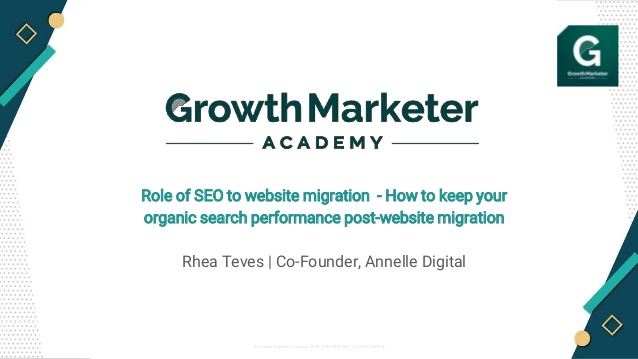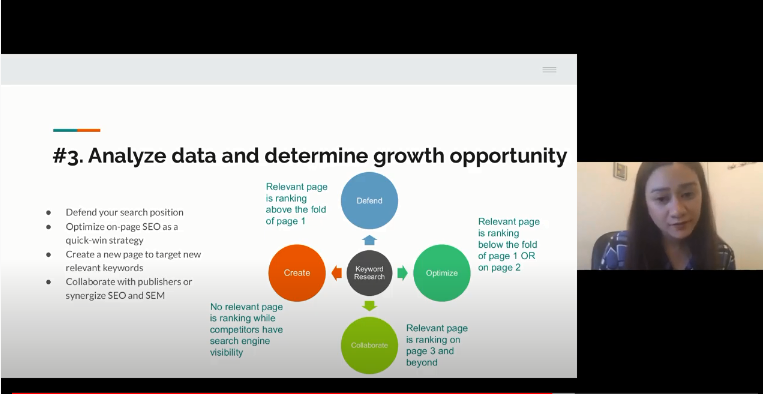Have you ever changed your website’s domain then all of a sudden, there is a drop in site traffic? Or added or removed a page from your site, or changed your site’s structure and wonder why you’re getting low website visits after?
Well, if that’s the case, you haven’t migrated your website correctly.
A website migration is a term used to describe any event whereby a website undergoes substantial changes to the site’s location, platform, structure, content, design or UX.
If done improperly, these changes may affect the traffic that your website receives thereafter. For most people, they would not care, thinking traffic will return eventually. But for us SEOs, this can be bad for business.
And this is the topic that Growth Marketer Academy in Hong Kong wants to discuss with its community of professional marketers. On the eve of January 26, 2021, GMA invited Annelle Digital’s co-founder, Rhea Teves, to share her expertise on the matter.

In a webinar entitled “The Role of SEO to website migration – How to keep your organic search performance post-website migration”, Rhea shares the essential factors of the entire site migration process – from strategy, optimizing, through to improving performance post-migration, and explains why you can stand 100% chance to execute a site migration without suffering significant losses.
Rhea Teves is not new to the digital marketing scene. Aside from being the co-founder of Annelle Digital, a digital marketing agency based in the Philippines, she also is a well-rounded SEO professional with over 10 years of experience managing global and APAC region SEO projects, both from in-house and agency roles. Along with this, she has experience managing regional website migration projects.
“When you’re migrating a website, you must make sure it (the website) is crawlable or indexable. You must think of the technical SEO elements. And technical part is the foundation of any SEO project” was Rhea’s opening statement.
“If you don’t want to incur a huge cost or expense post site migration, you must consider SEO at the beginning (of site migration).” She then added.
This is true in so many ways. In an article in BBC last 2019, they ran a story of how ASOS, a British online fashion and cosmetic retailer, reported an 87% decline in profits since 2018, with SEO and organic traffic partly to blame.

“To stay competitive, the retailer launched 200 versions of its website depending on which country the customer is in, which had a negative effect on ASOS’ search engine rankings.” according to the BBC article.
The 200 versions of the ASOS website that the BBC is referring to here are 200 different regional domains used to rank for different languages and regions around the world. ASOS suffered from this, thus the 87% decline in profit.
Any site launch, domain change, or large site change should have an SEO strategy in place to ensure that organic performance is protected.
So why do we need to have a website migration?
Here is a list of the main reasons why.
- Add or remove pages
- Rebranding or domain change
- Site hierarchy change
- SEO driven changes
- http to https
- mobile first indexing
- introduction of accelerated mobile pages
Rhea then shared that there are 4 factors to consider when optimizing your website for SEO during website migration
4 factors to consider when optimizing your website for SEO during website migration
Factor 1: Audit the website and discuss Technical requirements to developers
In website migration, you need first to audit the existing website to see what’s working well or not working well in terms of SEO.
.After gathering audited data, you need now to come up with technical SEO requirements with the given findings that you will then give to your developer.
The objective of the technical SEO requirements is to make sure that the website is crawlable, indexable, and equipped to rank.
Technical SEO requirements
- Infrastructure and Components
- Site Hierarchy
- URL Structure
- Status Code and Redirects
- Robots file and XML sitemap
- CMS Functionality for on-page SEO

Factor 2: Make sure you have the right tools
Here are the essential tools that an SEO specialist must be familiar with in order to perform our roles.
1. Crawling Tool
We need to know the current and on-page SEO elements. Examples are Screaming Frog / DeepCrawl / OnCrawl
2. Analytics
It shows us the website performance i.e., the pages with traffic and conversions, and what channels are being used. Examples are Google Analytics / Adobe Analytics
3. Google Search Console
This is a free Google tool that provides reports that can help measure your site’s search traffic and performance.
4. Backlink Tool
This shows what are the landing pages of your website’s backlink. Examples are Ahrefs/ Majestic
5. Ranking Tool
Tools that show what pages have migrated and how they are performing pre and post-migration in terms of ranking for important keywords. Examples are BrightEdge / Accuranker / Advanced Web Ranking
Factor 3: Gather and Analyze data
Use the SEO tools to gather and analyze data needed for website migration.
First, gather a list of active pages and determine what are the must-have pages to migrate.
Second, determine what pages not included in the must-have list that are receiving the most traffic or bringing the most conversions.
Third, create a list of the old URLs including HTML, pages, PDF, images, and paid media landing pages
Lastly, extract the keywords driving traffic to the site and pages receiving organic traffic and then track them.
Factor 4: Retain existing website authority
Probably one of the most important factors in site migration. You need to redirect pages to keep link equity.
Link equity is a search engine ranking factor based on the idea that certain links pass value and authority from one page to another. Links that pass equity are one of many signals that Google and other search engines use to determine a page’s rankings in the SERPs.
So, it is important that if you have existing link equities, to redirect them to your new site via a 301 permanent redirect or a 302 temporary redirect.
Steps to take to keep and further improve your SEO performance
The four factors mentioned earlier is just to ensure that the existing website’s performance is retained. But your SEO effort must not end there. It is a continuous effort here on out, to better improve your website’s SEO performance. You need to consider additional strategies to increase SEO performance.
Track SEO performance
Prepare a pre-launch performance report and a post-launch performance report in order to compare the data and see how you are doing after site migration.
Check the ranking, organic search traffic, page loading speed, Google search console queries and pages, and if there are any 404 pages or broken pages.
Conduct quarterly website health check.
You should conduct a quarterly website health check in order to see if there are any irregularities in your site. By using the crawling tool like Screaming Frog, you can see if your site’s internal links can be crawl.
You can check if there are missing, duplicate, too long/too short tittle tag, meta description, and H1. If you have broken links, missing canonical tags, and no-index and no-follow directives.

Analyze data and determine growth opportunity
By using the Google data studio dash board, you can determine opportunities for your website’s SEO performance to grow.
You can optimize your content or on-page SEO as a quick-win strategy. Or create a new page and target new relevant keywords. You can also collaborate with publishers or synergize your SEO and SEM efforts.
Move on to off-page SEO
Off page SEO refers to actions taken outside of your own website to impact your rankings within search engine results pages.
Think about off-page SEO as building your site’s authority, and without this, your site won’t outrank those that already have higher authority. It is important for businesses to build citations for the brand to be recognized.
Google tend to give preferential treatment to recognizable brands leading to the website to rank easier, generate better click rates and less likely suffer from SEO penalties.
Link building is often considered to be the main off-page tactic, but this also includes tactics such as content marketing, social media, appearing on podcasts, landing reviews, building local citations, and more.
Don’t stop optimizing your website for SEO
Optimizing the SEO of your site is a continuous process. Just follow the SEO cycle. Keep yourself updated with the algorithm updates. And adjust your SEO strategy accordingly to changes in the algorithm.
And with that ends the webinar of Growth Marketer Academy. Present marketers learned valuable insights regarding the migration process, and the importance of SEO in site migration.
Visit this link to see the deck that we have used in the webinar:
Or visit this Youtube video to watch the replay:




Recent Comments